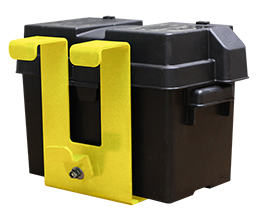You might want to consider one of these battery boxes.
http://www.torklift.com/index.php/products/auxiliary-battery-storage/hiddenpowerIt will hold up to a group 31 battery, that is about 100 AH. If you get AGM, then you will not need to look at it often. It should last 2-3 years.
100 AH is plenty of power if you will allow a solar system to recharge it daily. If you are using the power during the day, then the solar is suppliing it, not the battery itself. The battery will only supply the amps not supplied by the battery.
The 100 amp per hour alternator on all trucks will fully charge the battery in a hour or so. Most trucks these days come with 130+ amp alternators, and even 100 amps is more than adequate.
You can get a 300 watt inverter to run from the new battery. Then install a 12 volt relay between a wire going from your alternator to the relay to a 100 amp fuse, to the battery. Then a wire going from the battery say #10 wire to a cigarette lighter receptacle. Then plug the inverter into the new cigarette lighter receptacle, and you are ready.
Hooking up the solar is really easy. Just run the wires to the new battery, through a controller. Clip them down to the cap surface to prevent them from moving around in the rain and wind. Bolt the solar panels with standard brackets like used for RV's. Plenty of rubber roof sealant will prevent leaks into your bed cap.
100 watts will provide about 30 AH daily, more in your long summer days, less in the winter. I would say start with 2 panels if you do not plan on driving around much, or 1 if you will be driving more than 30 minutes daily, or plan on running the engine a bit if you need to recharge everything.
THis is a good place to look at solar panels.
SunElec.com They had 140 watt panels on sale a few weeks ago for $229 that have aluminum frames, so you have something to bolt the frame mounts to on the RV.
FOr mounts, I cut 6" long 2" angle aluminum into 4 mounts, 1 for each corner. 3 holes for 3/16" #10 screws into the roof of my RV, and a 5/16" for a 1/4" bolt into the panel frame. This keeps the panels 1" above the roof surface, and cooler panels run better. If you have a fiberglass cap, then 2 machine screws and flat fender washers on the inside will work best.
You can run grey UV rated direct burial wire on the roof of a RV, but it might not look "Good" on a pickup cap, unless you have a location to run it not visible from the street. You might want to drill a hole into the cap under the panel proposed location, and run the wiring inside, out of sight. Seal it with rubber roof sealant, it works great even on fiberglass. . .
I have found a Hawkins directional Wi-Fi antenna handy, it will pick up a wi-fi signal from over 800 feet away, and have good speed while using it. Because it plugs into a USB port, it can be set on the roof, or outside the windows for longer range. For some reason the windows seem to block some of the wi-fi signal.
You might also look into cell phone based wi-fi hot spots. Chevy is using some of their cars running a system where you could use the car as a hot spot. Not sure exactly how it works, but there are 'cell' phone hot spots that are not phones at all, but use cell towers to act as the hot spot in your home. I am sure that they make some of these wireless. . .
What about a GPS program for your laptop? I used to use DeLorme program on my laptop to run a GPS on a 15" screen, much easier to plan a trip, especially a long RV trip. It has a GPS receiver that plugs into my laptop USB port.
Good luck,
Fred.

